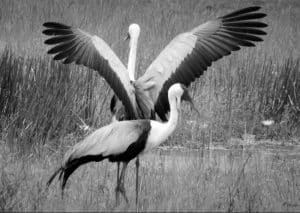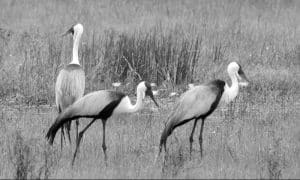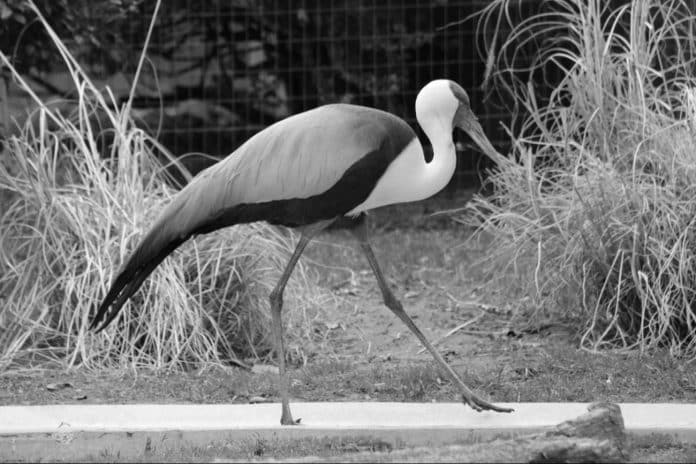Introduction to the Wattled Crane
The wattled crane (Bugeranus carunculatus) is a large bird that is found in sub-Saharan Africa, with a population that is estimated to be between 6,000 and 8,000 individuals. The bird is named after the wattles that hang from its neck, which are used for display during courtship and territorial defense. The wattled crane in Tanzania is a long-lived bird, with a lifespan of up to 25 years in the wild. It is a social bird that lives in groups of up to six individuals, with breeding pairs remaining together for life.
Importance of Tanzanian Wetlands

The wetlands of Tanzania are of great ecological importance, as they provide habitat for a wide variety of plant and animal species, including many that are endangered or threatened. Wetlands are also important for their role in regulating water flow and quality, and for their contribution to the global climate system.
Tanzania’s wetlands are particularly important for their role in supporting the migration of birds, many of which travel thousands of kilometers each year to breed and feed in these habitats. The wattled crane is one such bird, and its presence in Tanzania’s wetlands highlights the importance of these habitats for the conservation of biodiversity.
Habitat and Distribution of Wattled Crane in Tanzania
The wattled crane is found in a variety of wetland habitats in Tanzania, including floodplains, marshes, and riverine habitats. The bird is most commonly found in the eastern part of the country, including the Selous Game Reserve, the Kilombero Valley, and the Rufiji Delta.
The distribution of the wattled crane in Tanzania is closely linked to the availability of suitable habitat, which is threatened by human activities such as agriculture, livestock grazing, and mining. Wetland degradation and loss is the primary threat to the wattled crane population in Tanzania.
Threats to the Wattled Crane Population
The wattled crane is classified as vulnerable by the International Union for Conservation of Nature (IUCN), with the global population estimated to be between 6,000 and 8,000 individuals. In Tanzania, the population is estimated to be between 200 and 500 individuals, with the Selous Game Reserve and the Kilombero Valley being the most important breeding areas.
The primary threats to the wattled crane population in Tanzania are habitat degradation and loss, as a result of human activities such as agriculture, livestock grazing, and mining. Hunting and egg collection are also a threat in some areas. Climate change may also have an impact on the distribution and abundance of the wattled crane in Tanzania.
Conservation Efforts for the Wattled Crane in Tanzania

Conservation efforts for the wattled crane in Tanzania are focused on protecting and restoring wetland habitats, as well as reducing the impact of human activities on these habitats. The Tanzanian government has established a number of protected areas that are important for the conservation of the wattled crane, including the Selous Game Reserve, the Kilombero Valley and the Rufiji Delta.
Conservation organizations such as the Wildlife Conservation Society (WCS) and the Frankfurt Zoological Society (FZS) are also involved in conservation efforts for the wattled crane in Tanzania. These organizations work with local communities to promote sustainable livelihoods and reduce the impact of human activities on wetland habitats.
Ecotourism Opportunities for Observing Wattled Cranes in Tanzanian Wetlands
Ecotourism provides an opportunity for visitors to observe the wattled crane in its natural habitat, while also supporting conservation efforts. There are a number of ecotourism operators in Tanzania that offer tours of wetland habitats, including those that are important for the conservation of the wattled crane.
Visitors can observe the wattled crane in its natural habitat, as well as other wildlife species such as hippos, crocodiles, and a variety of bird species. Ecotourism operators also provide educational opportunities for visitors to learn about the importance of wetland habitats and their role in supporting biodiversity.
Best Time to Visit Tanzanian Wetlands for Wattled Crane Sightings

The best time to visit Tanzanian wetlands for wattled crane sightings is during the dry season, which runs from June to October. During this time, water levels in wetlands are lower, making it easier to observe the birds. The dry season is also a good time to observe other wildlife species, as they congregate around remaining water sources.
Other Wildlife Species Found in Tanzanian Wetlands
Tanzanian wetlands are home to a wide variety of wildlife species, including hippos, crocodiles, and a diverse range of bird species. Other notable species include the African fish eagle, the Goliath heron, and the saddle-billed stork.
Wetlands are also important for their role in supporting fish populations, which are an important food source for many local communities. The conservation of wetlands is therefore important not only for the conservation of biodiversity, but also for the sustainable use of natural resources.
Responsible Tourism Practices for Visiting Tanzanian Wetlands
Responsible tourism practices are essential for minimizing the impact of tourism on wetland habitats and their wildlife populations. Visitors should adhere to the following guidelines when visiting Tanzanian wetlands:
- Follow designated trails and avoid disturbing wildlife
- Do not litter or leave any waste behind
- Avoid using single-use plastics
- Respect local customs and traditions
- Support local conservation efforts and sustainable livelihoods
Conclusion: The Significance of Preserving Tanzanian Wetlands for the Wattled Crane Population
The wattled crane is a charismatic bird that highlights the importance of wetland habitats for the conservation of biodiversity. Tanzania’s wetlands are of great ecological importance, and their preservation is essential for the conservation of the wattled crane and other wildlife species.

































